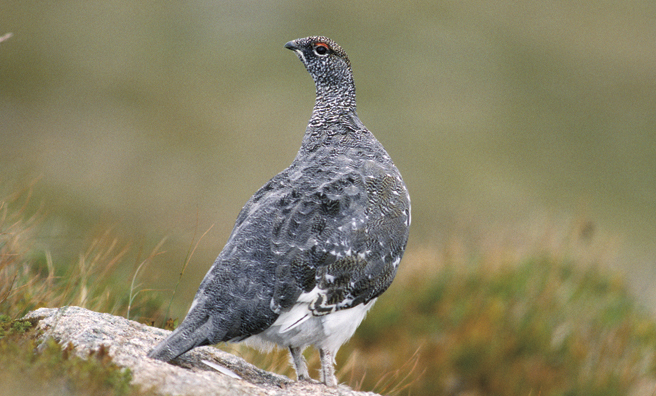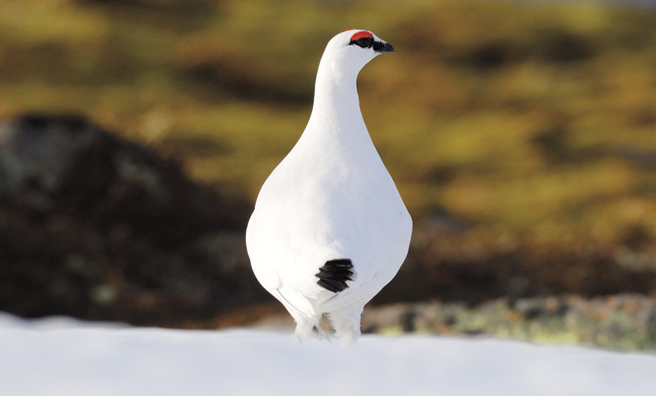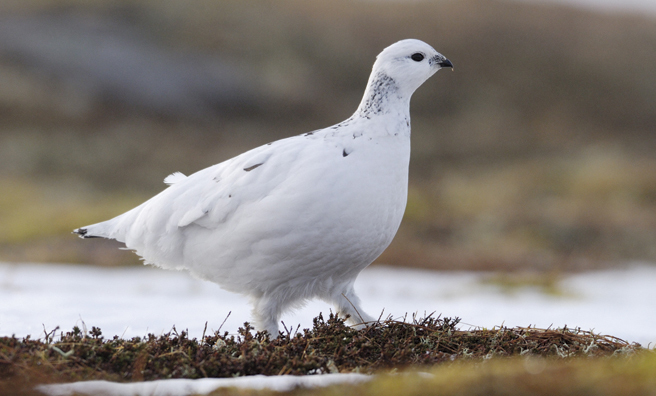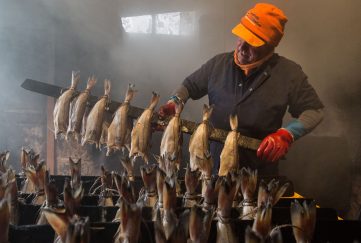Ptarmigan Watch
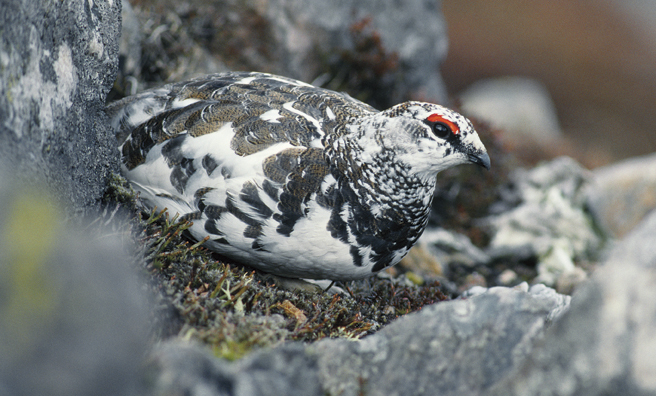
This rock has been sitting with its back to me for quite a while now.
Time has stalled, become meaningless, which if I’m honest is the way I like it best.
Spring is the quickest of seasons: no sooner have I got used to the first mid-March chiffchaff quavers in the thicket across the road than it is midsummer’s day and I have not achieved two-thirds of the spring adventures I promised myself at chiffchaff time.
If I am smitten by it, it must become a part of the repertoire of familiar landscapes
My temperament has a lot to do with that, for what works best with me is to reacquaint myself with a handful of familiar landscapes, familiar from years and years of following old paths through the land like an Australian aborigine pursuing the songlines of ancestry. Forays to new lands are few and far between, although when I do reel one in, if I am smitten by it, it must become a part of the repertoire of familiar landscapes. I hardly ever go anywhere just once.
So my way of dealing with the sheer pace of spring is to try and ignore time altogether. I walk the familiar paths slowly with my eyes wide open and watch the season whiz by. If I sit still often enough there is a chance that I can pin enough of it down with a paper and pencil to make sense of it. There is nothing I can do about the fact that summer is just under the horizon so I make my peace with the march of the seasons, make spaces in my life for nature to fill.
Might this be the 50th anniversary of the first time I saw a ptarmigan?
This is one such space. It is a bouldery tract of the Cairngorms plateau and while I have been sitting here I have also been wondering (in a timeless sort of way) if this might just be the 50th anniversary of the first time I saw a ptarmigan. I honestly cannot remember how old I was or what the circumstances were, but I know it was among the hills of north Angus and coincided with the first of my teenage forays when I began to cut my teeth on mountain country.
I know of no-one who loves the Cairngorms who does not also love ptarmigan
Wherever nature’s laws still hold sway, wherever the word “wild” still fits the landscape’s clothes, I habitually imbue a single creature with the role of the “spirit” of the place. I’m not quite sure what I mean by the word but it seems to carry the sense of a presence, a voice, or some other trait that attunes uniquely to the demands of a particular landscape. For example, I think of red-throated divers in Shetland, the boisterous St Kilda wren, golden eagles in the Skye Cuillin, alpine lady’s mantle in Glencoe (an unlikely emblem, I know, but there are no rules), buzzards in Knapdale, ospreys in Menteith, and I know of no-one who loves the Cairngorms who does not also love ptarmigan.
In the midsummer month of June, ptarmigan are the shades of the plateau, the broken tones of gravel and scree and old snow, and the lumpen shape of these rounded granite boulders where they sit and sometimes snore (the clarion not of sleep, but of watchfulness). Sound is as likely to guide your eye to a ptarmigan as anything. Even in movement, running or slow-marching among the boulders, they have something of the naturalness of winds and go undetected.
And whereas the dotterel flies into this landscape to nest and sits tight and makes do with what clothes it has packed for the journey, the ptarmigan is hefted to the high Cairngorms and dons and doffs the mountains’ colours more or less as the mountain does, a rolling programme of moults and mottles from perfect midwinter snowfield white to perfect midsummer boulderfield mish-mash. This particular boulder has had its back to me for quite a while now.
The ptarmigan and I have at least some of the same needs
High summer works better for me here than anywhere else I know. The ptarmigan and I have at least some of the same needs (I bring my food up with me on my back, the ptarmigan eats the raw mountainside): the unfettered space which is the one essential common to all the tribes of the midsummer plateau, a long and wide view of the approach of eagle, raven, fox, and the other predatory tribes that trouble the sitting ptarmigan’s peace of mind (and perversely enhance mine), and the sense of being in the right place at the right time – if only because being anywhere else doesn’t work.
I was pleased to recognise this rock where I sit with my back against its warm midsummer curve. I was here two or three summers ago, and several summers ago before that. The first time was a chance encounter, and the rock recommended itself to me because fifty yards away there is another rock on which a snow bunting was singing. So I sat here to watch and listen, and that occasion was also a timeless one.
The second time (or it may have been the third for I don’t keep notes of these kind of things – I’d never make a proper naturalist) was a day when the sky fell as I rose to meet it, and in thick, chilling cloud that swirled eerily on a disgruntled wind I was almost head-butted by a reindeer that consolidated into itself out of blur in the gloom over a few seconds, then grunted a rebuke or a greeting (how is one to know when one is not a reindeer?) then turned away and unconsolidated out of itself again, into a blur and then nothing at all over a few more seconds, and that happened just yards from here.
But now on this, my most recent meandering across the midsummer plateau, I have sought out this milestone (as I think of it) of a rock, a milestone on the journey of all my Cairngorms travels, and I find that a little less than halfway between here and the rock where the snow bunting sang, a ptarmigan has chosen to sit among rocks that look like sitting ptarmigan, and with its back to me, the better to confound my watcher’s eye with its rock-stillness.
Laying eggs at 4000 feet is a bit of a risk
The plateau is no place for early nesters. Spring is a sluggard in a landscape where winter is such a moveable feast. I have been snowed on here in every month of the year, and whatever the theoretical season of the year 4000 feet below where they make these sorts of distinctions, flaming June is just as likely to wear an icicle on the end of its nose. So a ptarmigan on eggs deep into June is par for the course, and still a bit of a risk. Laying eggs at all at 4000 feet is a bit of a risk.
I have heard it said (with some authority) that you can walk up to a sitting ptarmigan, put your hand under it and lift it from the nest without protest. It was information that I took in with a wince, for three reasons. One is: why would anyone want to do such a thing? Two is: someone has obviously done it to know that it was possible, which is shameful in itself. Three is: I tend to start thinking dark thoughts in such circumstances, veering towards the unworthy notion that the hand that performs such a feat should be severed at the wrist by way of example, or at the very least have a ptarmigan-sized granite boulder dropped on its fingers. You have been warned.
I have no way of knowing if it knows it is safe in my company
This ptarmigan is safe from all such considerations, although obviously I have no way of knowing if it knows it is safe in my company. When I came here and sat down, it was out of habit, and innocent of the ptarmigan’s presence. I had been sitting with my back to my milestone rock for at least a quarter of an hour (my hasty guess in the enveloping ambience of timelessness) before I noticed that one of the hundreds of boulders spread out in front of me was no such thing. The further end of it was much narrower and more rounded than the closer end and it was canted at an angle to the rest of it, and a jet-black jewel glowed there and held a pinpoint of bright white light and occasionally blinked lazily. The boulder with its back to me was nevertheless watching me over its shoulder, and it was clear to me then that it had been watching me for some time.
The ptarmigan and I were both relaxed by this time, so I did what I had planned to do when I sat down which was to eat a late lunch enjoying the view and the company. It was one of those situations which I have only ever encountered on the plateau or in Orkney, where the sky extends down below me through 360 degrees, and because I am sitting down no other land is visible anywhere other than the mountain I am sitting on.
She knows the plateau as I will never know it
The realisation creates an awareness of the remarkable nature of the Cairngorms plateau as a landscape, for we have nothing else like it, and neither for that matter does much of mainland Europe. It is a specialist’s landscape; to live here through four seasons requires a specialist’s capacity to thole its worst excesses. That simple truth, as much as anything else, is why I think of the ptarmigan as the spirit of this high and lonely place, and that hen bird sharing this hour with me is incubating the spirit as she broods her eggs. She knows the plateau as I will never know it, because she is born to it.
Her head moves, she mutters a soft croak, and her mate walks up to her through the boulders. I never saw him arrive. It is possible, of course, that he was there all the time, pretending to be just another boulder with its back to me.
- Summer plumage (Pic: Laurie Campbell)
- A male ptarmigan with winter plumage (Pic: Laurie Campbell)
- A female in winter, Cairngorm National Park (Pic: Laurie Campbell)
- A male ptarmigan blending into its surroundings in the Cairngorms (Pic: Laurie Campbell)
Ptarmigan facts
- The ptarmigan is a medium-sized gamebird of the grouse family.
- They can survive intense cold environments, blizzards and gales. Their foot feathers help with insulation and act as snowshoes.
- The bird’s feathers change colour throughout the seasons to match the landscape – white in winter, grey/brown/black in summer.


